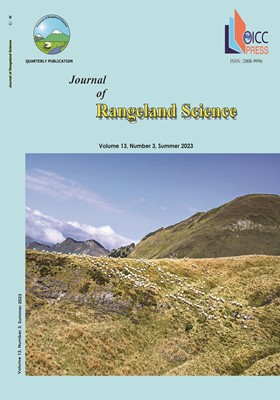Modeling Potential Habitats for Gymnocarpus decander Using Multivariate Statistical Methods and Logistic Regression (Case Study: Sistan and Baluchestan Province)
محورهای موضوعی : Climate Change
Masome Narouei
1
,
Seyed Akbar Javadi
2
,
Morteza Khodagholi
3
![]() ,
Mohammad Jafary
4
,
Reza Azizinezhad
5
,
Mohammad Jafary
4
,
Reza Azizinezhad
5
1 - Rangeland Department, Faculty of Natural Resources and Environment, Science and Research Branch, Islamic Azad University, Tehran, Iran
2 - Rangeland Department, Faculty of Natural Resources and Environment, Science and Research Branch, Islamic Azad University, Tehran, Iran
3 - Associate Professor, Rangeland Research Division,Rangelands and Forests of Institute Research,Agricultural Research Extension Education Organization (AREEO), Tehran, Iran
4 - Department of Reclamation of Arid and Mountainous Regions, Natural Resources Faculty, University of Tehran, Karaj, Iran
5 - Assistant Professor, Department of Biotechnology and Breeding, Science and Research Branch, Islamic Azad University, Tehran, Iran
کلید واژه: Climate Change, Rangeland management, Habitat distribution, Species modeling,
چکیده مقاله :
Identification of habitats and suitable environmental conditions for the presence of various animal and plant species is one of the key issues in ecology and environment modeling. In Iran, Gymnocarpus decander species is the main and most abundant plant of the Baluchi flora, especially in the rangeland areas. Due to its high resistance to harsh environmental conditions and salinity, this species can be useful for rangeland reclamation and restoration. In order to assess potential habitats of G. decander in Sistan and Baluchestan province, Iran, this research was conducted in May 2020 using multivariate statistical methods including factor analysis, clustering and logistic regression. To do so, the map of real habitats ofG. decander, was modeled using altitude and 62 climatic variables which were prepared using 24 meteorological stations across the province and neighboring. Climatic variables were reduced to 5 factors using PCA, including temperature, precipitation, radiation, dust and maximum temperature, which accounted for 88.3% of the climate change in the studied region. According to the regression models, the precipitation, temperature and altitude variables were the most significant independent variables (p <0.05) which influence the potential habitats ofG. decanderin the study area. Also, the study area was divided into 5 groups (G1:G5). The results suggest that models are more accurate in homogeneous groups than in the whole region. The Kappa coefficient and perdition accuracy had the highest and lowest values for G1 (68% and 88%) and G5 (19% and 59%), respectively. The results also showed that currently, 48.2% of the studied region has actual habitats. While the modeling results based on the model of the whole region showed that the potential habitat area of this species was 52.3% and based on the grouping models, it was 53.7%. Therefore, based on differences between actual data and modeling result, 4.8% of potential habitats have noG. decander. Also, results indicate that the G4 region with altitude range between 800-1250 m, growth season mean temperature was about 16 °C and annual precipitation about 170 mm was the main habitat forG. decanderin Sistan and Baluchestan. According to the results of this study, G. decander is an endangered species and it is necessary to plan long-term management to preserve and restore its habitats in the arid regions of southeastern Iran.


